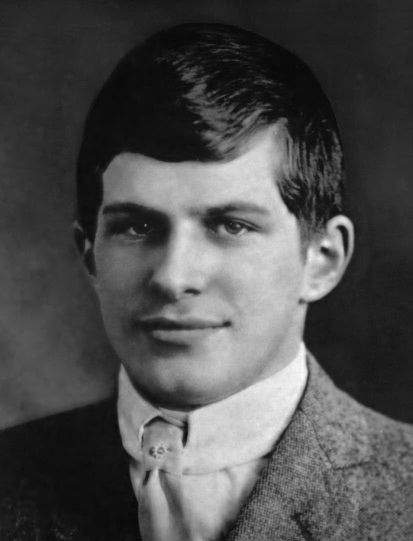All About William James Sidis: A ‘Smartest Man Ever’

Image Credit Pinterest
William James Sidis was a less-known American child prodigy with great mathematical and linguistic skills. He often claims the title of the ‘Smartest Man Ever’. James was estimated to have an IQ in the 250–300 range. He wrote the book “The Animate and the Inanimate”, which was published in 1925. In the book, he speculated about the origin of life in the context of thermodynamics. Young Sidis was truly a genius and intellectual phenomenon. His childhood achievements ranked those of Thomas Macaulay, John Stuart, and Johann Goethe.
Williams James Sidis first became popular for his precocity then for his precocity and later for his eccentricity and withdrawal from public life. Even, he avoided mathematics altogether, writing on other subjects under several pseudonyms. At just the age of 11, he went to Harvard University and, as a young, was called to have an IQ between 250 and 300. He knows 25 languages and dialects. Some of these statements have not been verified, but his contemporaries, including William James, Daniel Forst Comstock, and Norbert Wiener, accepted that he was immensely intelligent.
Early Life
William was born on 1st April 1898, in beautiful New York City to Jewish immigrants from Ukraine. His mother, Sarah Sidis (Mandelbaum), fled the pogroms with her family in the late 1880s. In 1897, she went to Boston University and graduated from its School of Medicine. His father, Boris Sidis had emigrated in 1887 to escape antisemitic and political persecution. James was named after his godfather, Boris’s friend and colleague, the American philosopher William James. Boris published many books and articles, was also a psychiatrist and performed pioneering work in abnormal psychology. Boris was a polyglot and his son also became one at a very young age.
His parents raised him to certain principles, although their method of parenting was criticized in retrospect and by the media. At just 18 months, William could read the New York Times. Reportedly, he had taught himself eight languages (Greek, Russian, Latin, Hebrew, French, German, Armenian, and Turkish) and also invented another ‘Vendergood,’ just by age eight.
His College Life
Although Harvard University had previously refused his father to enroll him at age 9 because he was still very young, at age 11, in 1909, William set a record by becoming the youngest person to enroll at Harvard University. In early 1910, his mastery of higher mathematics was such that he lectured at the Harvard Mathematical Club, attracting nationwide attention, on four-dimensional bodies. Norbert Wiener, the notable child prodigy cybernetics pioneer, who attended Harvard at the time and got to know about William, wrote in the book Ex-Prodigy: “The talk would have done credit to a first or second-year graduate student of any age…talk represented the triumph of the unaided efforts of a very intelligent child.”
At the early age of 16, on 18th June 1914, William completed his bachelor of arts degree, cum laude and got a mixture of A, B, and C grades. Shortly after completing graduation, William during an interview, said, “I want to live the perfect life. The only way to live the perfect life is to live it in seclusion”. The paper reported William’s vows never to marry, as he said women did not appeal to him. Later he flourish a strong affection for Martha Foley and attended Harvard Graduate School of Arts and Science.
Career
After completing his graduation, William James served as an assistant mathematics professor at Rice University in Houston, Texas. He taught undergraduate students and at the same time also wrote a book on Euclidean geometry. William taught three classes: Freshman Math, Euclidean geometry and non-Euclidean geometry. However, soon Wiliam got frustrated with his department and the disrespectful behavior of some students towards him. So he resigned from Rice University and went back to Harvard to study law. In September 1916, William studied law but then he dropped out of college in 1919.
Later Life
William took up socialist causes and got into jail in 1919 for participating in a communist-led anti-war rally in Boston. He served 18 months in prison by Roxbury Municipal Court Judge, Albert F. Hayden, under the Sedition Act of 1918. Since he had a celebrity-like status in the media, his arrest became headlines in many popular newspapers. He defended himself at trial and got 18 months in jail as punishment — a year for assaulting an officer and six months for rioting.
However, later his father managed to hold him in their sanatorium in New Hampshire for a year, instead of prison. His family took him to California, where he spent one year. At the sanatorium, his father set about “reforming” him and threatened him with transfer to an insane asylum.
In 1921, after returning to the East Coast, he lived an independent life and out of the public and media eye. He disclaimed his knowledge of mathematics and worked as a bookkeeper, often using an alias, and changing jobs and cities every time, so anyone couldn’t recognise him.
Life as a writer
He also wrote books. Some if them were under a variety of pseudonyms and some under his name. He wrote a book on streetcar transfer tickets and a 1,200-page history of the United States. He published a popular book on cosmology in 1925, in which he predicted black holes — 14 years before Chandrasekhar did. But primarily he fled his parents and he fled his childhood.
In 1933, William passed a Civil Service exam in New York City, with a low ranking of 254. In 1935, he wrote an unpublished manuscript, The Tribes and the States, that covered various aspects of Native American contributions to American democracy. He also invented a type of perpetual calendar which was to look for leap years.
He successfully lived his life without fame. It was until 1937 when an article published in ‘The New Yorker’ on what had the “boy genius” become, brought in back into the spotlight. He was very unhappy with the publishment of the article and filed a lawsuit against the publication to accuse The New Yorker magazine of libel and of violating his privacy. He won the settlement case in 1944. But at age 46, he died of a brain haemorrhage in 1944, in Boston.
William’s writing covered a broad range of subjects. He wrote about Native American history, Cosmology, and rail transportation and also introduced a language called Vendergood. In 1926, for this great work, they invited him to speak at the inaugural “genius meeting”. Winifred Sackville Stoner’s League hosted it for Fostering Genius in Tuckahoe, New York.
Intelligence is one of the many aspects of being a human. William’s life journey also shows that human life has so many different elements that intelligence alone can not always guarantee a fulfilling life.






